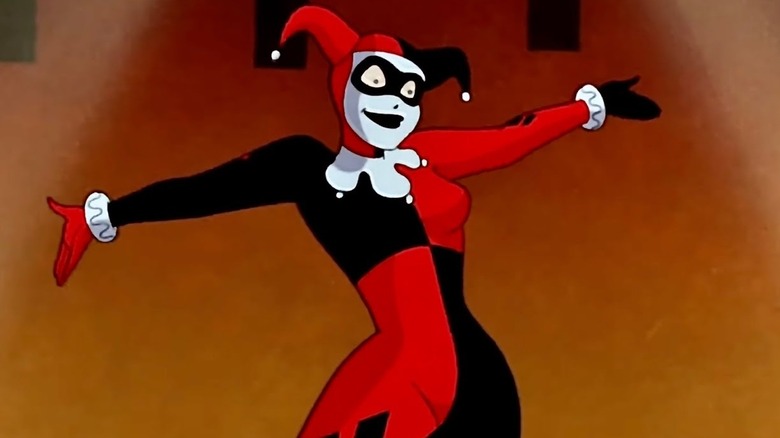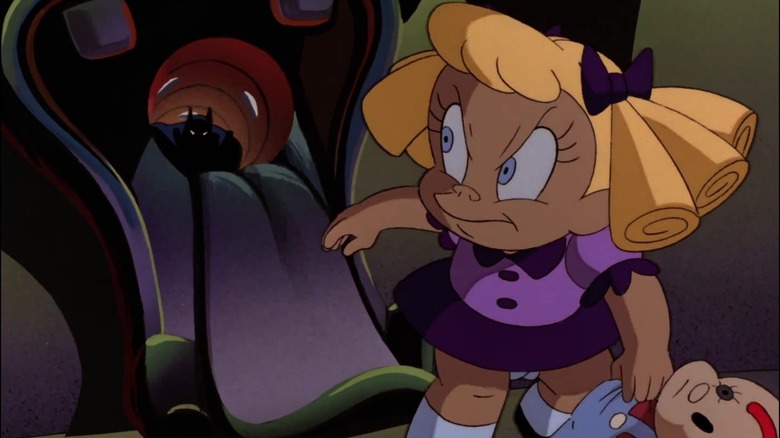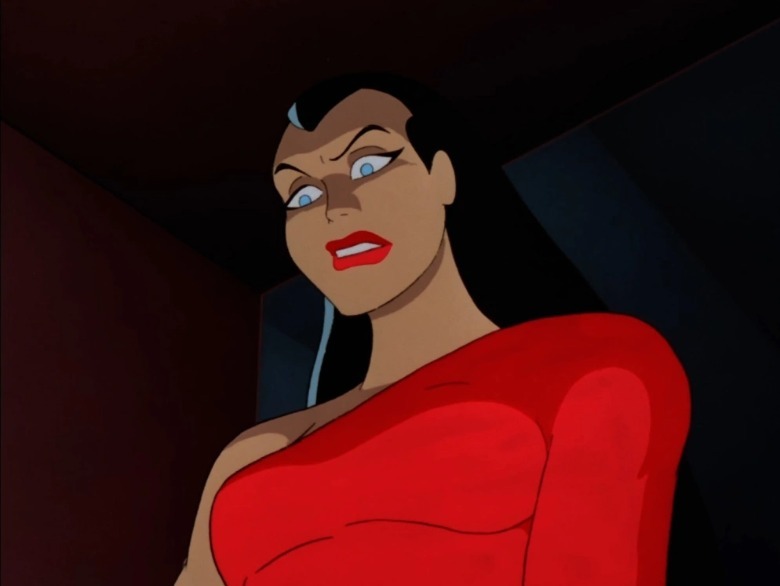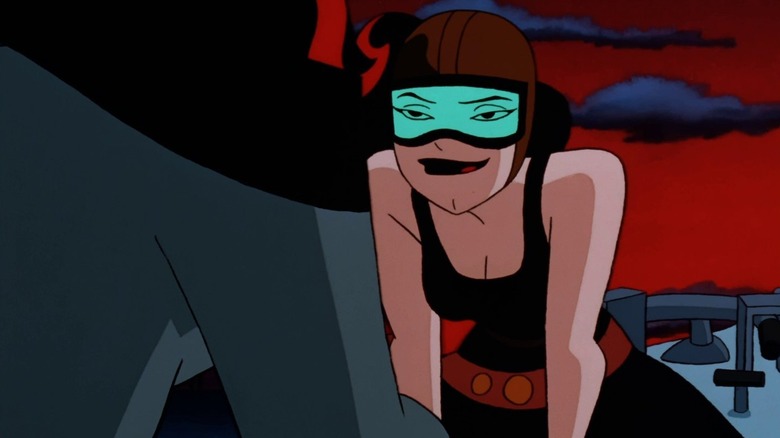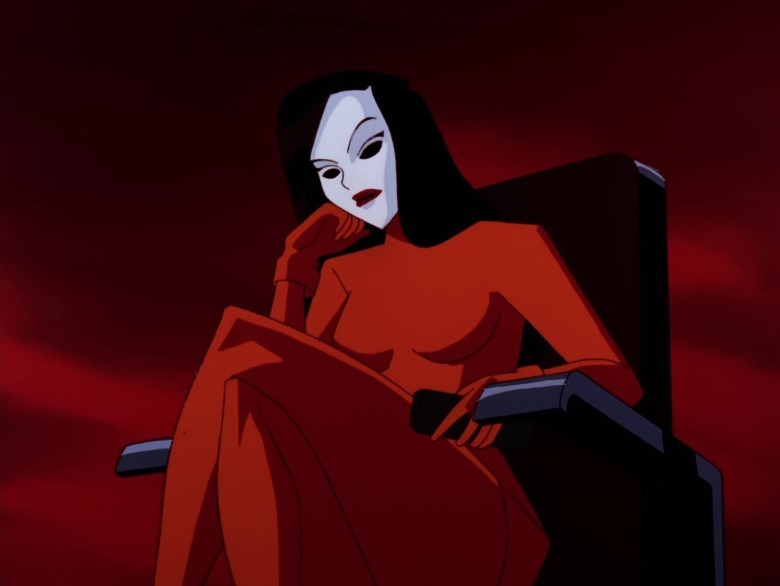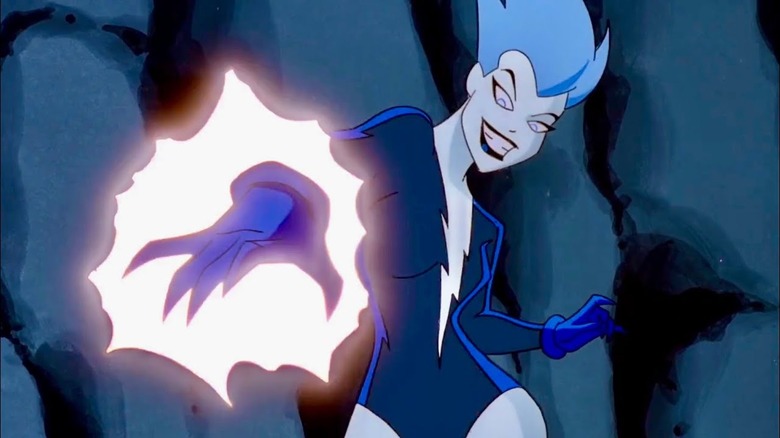Harley Quinn Isn't The Only Batman Villain The Animated Series Created
"Batman: Caped Crusader" was developed by "Batman: The Animated Series" co-creator Bruce Timm, with veteran Batman comic scribes like Ed Brubaker and Greg Rucka in the writers' room. Despite its familiar creative staff, "Caped Crusade" wound up making plenty of changes to Gotham City.
Take the villain of the first episode: the Penguin — but not as we usually know him. The "Batman: Caped Crusader" Penguin is gender-swapped from Oswald Cobblepot to Oswalda (Minnie Driver). She's got the trademark umbrella and beak-y nose, but Oswalda is neither the gentleman super-villain like most past Penguins, the repellent weirdo as played by Danny DeVito in "Batman Returns," or the waddling criminal upstart currently played by a costumed Colin Farrell in HBO's "The Penguin." The "Caped Crusader" Penguin is like an upper-crust Mags Bennett (Margo Martindale), the Kentucky mob boss villain of "Justified" season 2, complete with bumbling sons for minions.
Making Penguin a woman was a spur of moment suggestion by Timm during a conversation he shared with character designer James Tucker, which then took flight. Timm explained (in an interview with the Emmys website) that he thinks Batman needs more female villains, which is how he stumbled on the idea for Oswalda.
Batman's A-list rogues gallery is a bit of a lopsided sausage fest (though still not as bad as Spider-Man's there). You've got only Catwoman (who's barely a villain at this point), Poison Ivy, Talia al Ghul on her bad days, and Timm's own co-creation with Paul Dini, Harley Quinn.
Harley Quinn is easily one of the most lucrative DC Comics characters ever (even if her presence wasn't enough to save "Joker: Folie à Deux" at the box office). Her very creation is a famous story; she's a Batman character who began not in the comics, but in "Batman: The Animated Series" and then jumped into the source material even though Harley's creators didn't design her as a star. (Cesar Romero's Joker in the '60s "Batman" TV series sometimes had a blonde moll by his side — I think Harley was meant as a homage to that, nothing more.)
Knowing Timm feels this way recontextualized Harley's creation for me a bit, especially since "Batman: The Animated Series" introduced a few more original female villains. Did any of them capture lightning in a bottle twice?
The original villains of Batman: The Animated Series, from Red Claw to Baby-Doll
Not every original villain in "Batman: The Animated Series" was a woman. There was also tough-on-crime vigilante Lock-Up, an invisible man named Lloyd Ventrix, the joke villain the Condiment King, etc. But with Timm's comments in mind, I couldn't stop seeing a pattern.
The intended first episode of "Batman: The Animated Series" was "On Leather Wings," but "The Cat and the Claw, Part 1" wound up premiering one day earlier on September 5, 1992. This two-parter features Batman and Catwoman teaming up against the terrorist called Red Claw. With an unknown identity, Red Claw is initially assumed to be a man, but turns out to be a woman voiced by future Captain Kathryn Janeway herself, Kate Mulgrew.
Red Claw would return as the villain of the episode "The Lion and the Unicorn," but her terrorism gimmick was too unspecific to leave an impact. (It took until 2022 for Red Claw to show up in the comics.) If you need to stick Batman in a James Bond plot, you've already got Ra's Al Ghul as your heel.
Next there's one of my favorite "Batman" episodes: "Baby-Doll." The villain is actor Mary Dahl (Alison LaPlaca), born with a condition that prevents her from physically growing past age five. This allowed her to spend years playing a child on a sitcom, but when she tried to break typecasting she failed.
This episode especially is a Batman story designed for animation. Baby-Doll needs the exaggerated features and body language of a cartoon little girl (she resembles Elmyra Duff's blonde twin). Baby-Doll also runs into the problem of being best as a one-and-done villain; there's not much you can say about her character, and the Hell of being an adult trapped in a child's body, that her debut episode didn't. (Later episode "Love is a Croc" tried teaming her up with Killer Croc, for some mixed results.)
"Batman: The Animated Series" also introduced Renee Montoya, the Gotham police officer who rounds out the trio of Commissioner Gordon and Harvey Bullock. Renee, who like Harley has been brought over into DC's original "Batman" comics, also helps boost the number of women in Batman's supporting cast.
New Batman Adventures introduces Calendar Girl and Roxy Rocket
Follow-up series "The New Batman Adventures" only had 24 episodes, two of which featured the Caped Crusader facing off against an evil woman unseen in DC Comics. First, "Mean Seasons" starring Calendar Girl (not to be confused with date-obsessed villain Calendar Man). Once a model and actor named Paige Monroe (Sela Ward), Calendar Girl was drummed out of the industry for the crime of turning 30. Convinced she's horribly ugly (she's not), she wears a featureless white mask and sets out to get revenge on her former colleagues. ("Mean Seasons" makes for a fun companion piece with this year's beauty industry body horror picture "The Substance.")
Calendar Girl is similar to Baby-Doll; both characters explore how the entertainment industry boxes in women, and how your looks determine what jobs you get. "Mean Seasons" doesn't reach quite the same highs; nothing in it compares to the finale of "Baby-Doll," when Dahl sees the woman she should be staring back at her in a house of mirrors.
Then there's "The Ultimate Thrill," featuring Batman chasing super-villainess Roxy Rocket (Charity James) across Gotham City. Granted, she debuted in the tie-in comic "Batman Adventures," drawn in the style of "Batman: The Animated Series," before Dini and Timm brought her into the show itself.
Former stuntwoman Roxanne Sutton is an adrenaline junkie who realized the staged highs of the movies weren't enough. To get her kicks, she turns to crime and hopes to go out in a blaze of glory. I'll be blunt, Roxy Rocket is one of Timm's sexiest character designs — thanks to her red hair and cleft chin, she looks like John Romita Sr.'s Mary Jane Watson in a bomber pilot outfit, with a mouth full of innuendos too. "Batman: The Animated Series" was famous for pushing censorship to its limit; "The Ultimate Thrill" climaxes with Roxy writhing in joy, shouting "Yeah!" as her rocket crashes into a wall and explodes.
Dini gave Roxy a cameo in his 2006 "Detective Comics" run (specifically issue #822), but again, she hasn't reached nearly the same heights as Harley. Like Baby-Doll, she might just be best as a cartoon character; "The Ultimate Thrill" is structured completely around high-octane chase scenes that keep up constant momentum.
Why Bruce Timm has created plenty of female DC Villains
It's not just Batman who Timm thinks needs more female villains either. Superman has a less dynamic rogues gallery than the Dark Knight so on "New Batman Adventures" sister show "Superman: The Animated Series," Timm and co. brought in Darkseid from the Fourth World and whipped up some Harley Quinn-style originals.
First, Livewire/Leslie Willis, a shock jock who gains actual electric powers, and then Volcana/Claire Selton, who's like Charlie McGee from Stephen King's "Firestarter" all grown up. Livewire (who came to Gotham City to team up with Harley and Poison Ivy in "Girls Night Out") is probably the most successful of these after Harley; she too was brought over into the comics and several future TV shows.
Still, I think Roxy Rocket is the most revealing of these original villainesses. They're not there only for equal representation, Bruce Timm also just really likes drawing women. His distinctive style is most seen in his character designs; "Timm girls" share hourglass waists, round faces with a sharp chin, and full lips shining with color. Timm has even published a whole art book full of pin-up drawings in his style. Creating characters like Harley Quinn and Livewire might've just been him recognizing his own strength as an artist and creating his own opportunities to flex it.
